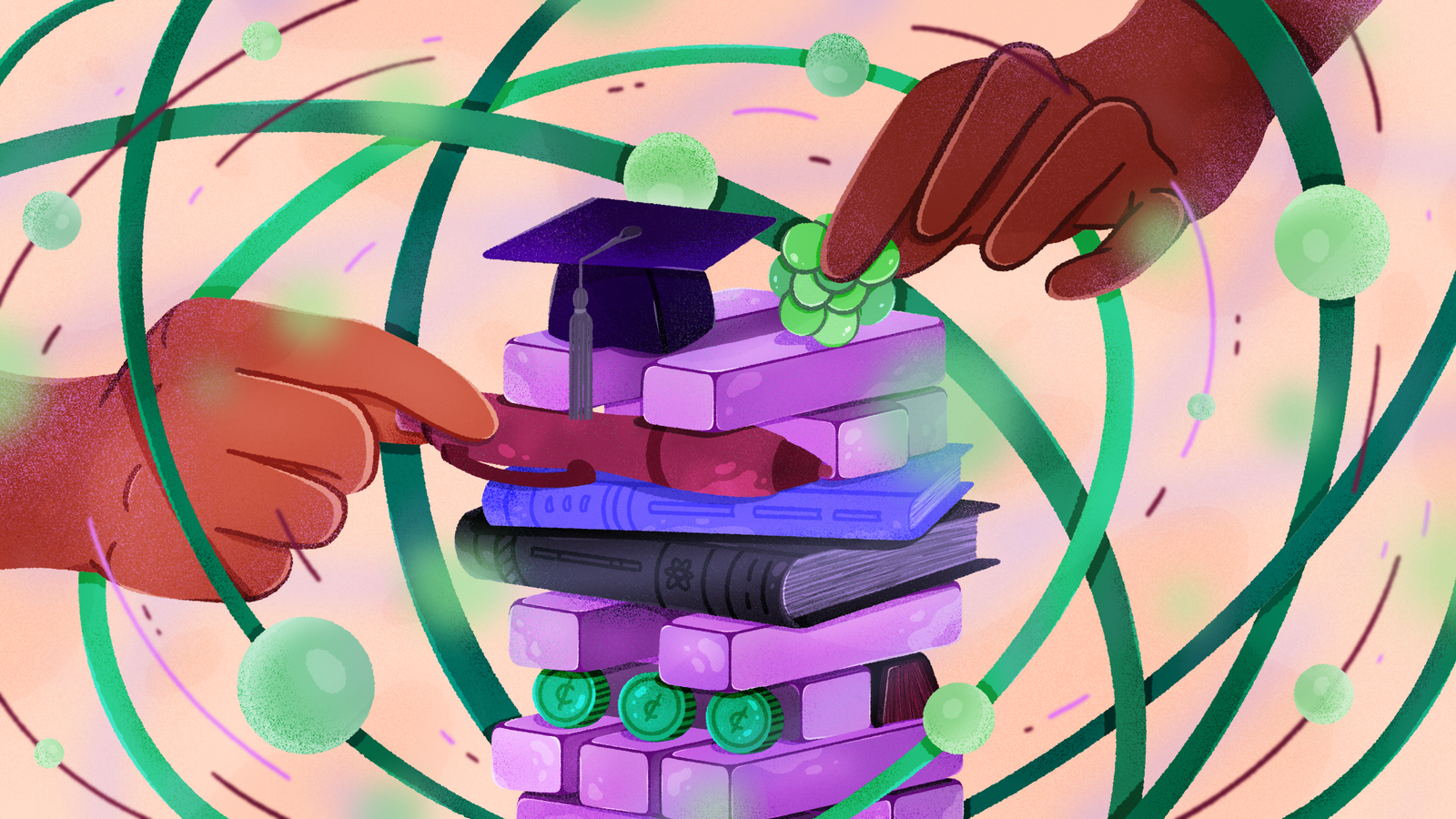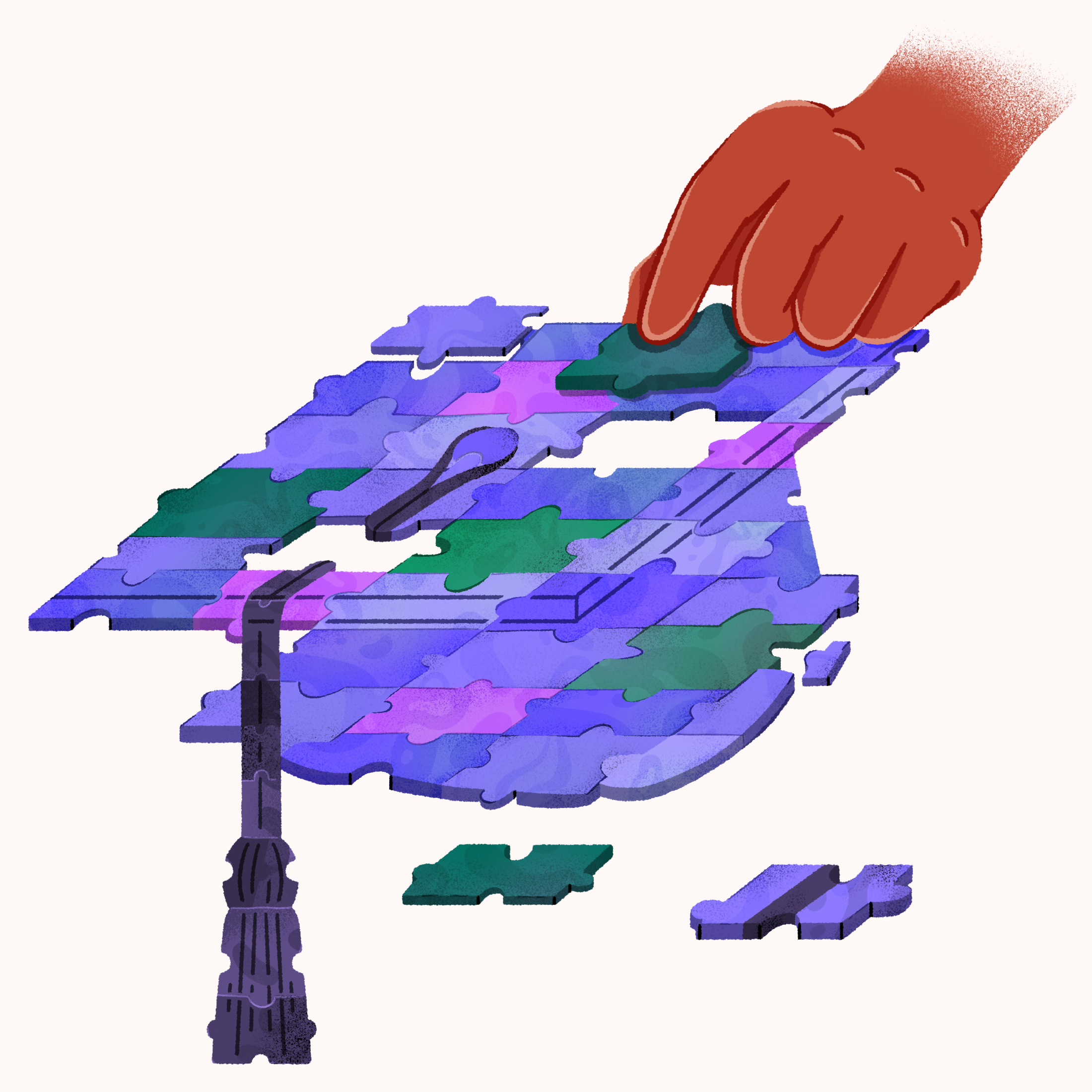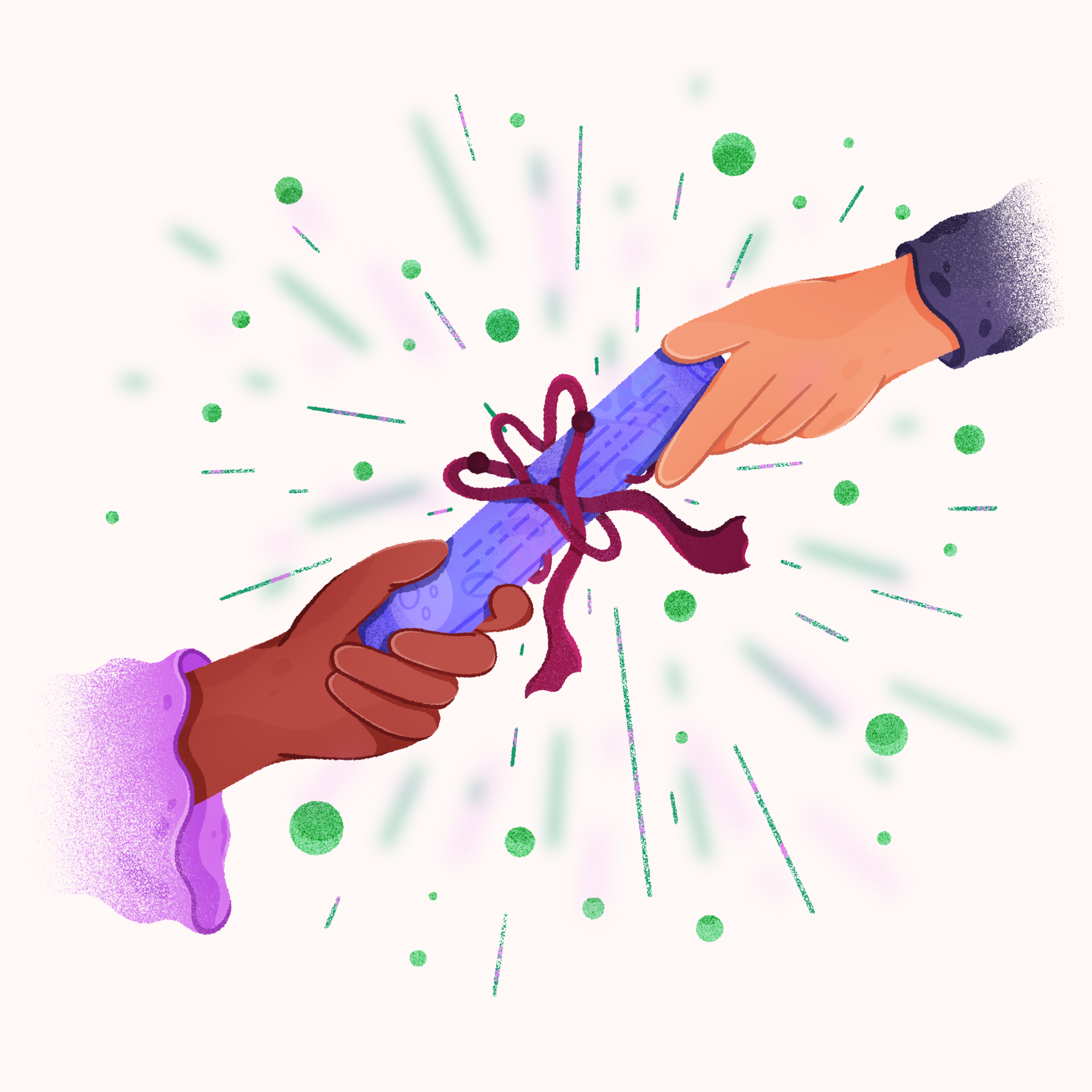In 2016, Robert Zill was stranded at the South Pole.
He had spent a week at Amundsen-Scott South Pole Research Station, but his flight back to the Antarctic coast had boomeranged due to bad weather. Since a new crew of researchers had already flown in to the station, he and his trapped colleagues had to sleep on frozen mattresses just pulled in from outside storage, placed wherever they would fit, until the weather cleared.
But overall, Zill counts his experience as one of the most thrilling of his life. That’s because he was there conducting research at IceCube Neutrino Observatory. He braved 30-below temperatures and 24-hour sunlight to ride snowmobiles between research buildings, examine the observatory’s sensors (which are attached to strings and deployed down into the ice, as deep as 2,450 meters below the surface), and connect with a tight-knit, global community of researchers—all as a student from College of DuPage, a public community college in northern Illinois.
Now, he tells community college students to not be afraid to get out of their comfort zones (as he did, literally) to try physics research and explore something new, “because the benefits cannot be overstated.
“It just opened up the idea of what was possible,” Zill says. “It was this huge project to learn more about the universe, and that gave me a better outlook on what I wanted to do.”
As the physics world seeks to recruit and retain the next generation of scientists and engineers, it often looks to undergraduate research experiences as the first step. And study after study has shown that these research experiences positively impact students’ completion of STEM programs, academic achievement and postgraduate STEM opportunities.
Students enrolled for credit at community colleges include those from the most underrepresented racial groups in physics: According to the American Association for Community Colleges, in 2023, 27% of those students identified as Hispanic; 12% as Black; and 1% as Native American.
But community college students, who as a whole make up 40% of all undergraduate students, face a unique set of hurdles in conducting research. Surveys show that the majority of community college students work while in school, and many have family commitments, leaving them little time to dedicate to any activity not strictly required for a degree.
“Getting two-year college students involved with research is normally pretty difficult because they are often laser-focused on getting on with their academic careers,” says Tom Carter, a physics professor at College of DuPage. “There is often a money issue, and every moment they spend on research is a moment they are not either taking a class or working at a job to earn money.”
A culture of undergraduate research can also be difficult to create among community college faculty. The standard four-year university model—in which professors and graduate students with well-funded research labs act as mentors to undergraduate students—does not apply to community colleges, where physics professors usually do not have labs or research funding.
Professors at these schools are not usually involved in large high-energy physics collaborations.
“Our job is teaching,” Carter says. “That’s what we want to do, and every moment we’re doing research is a moment we’re not thinking about teaching or how to improve our methods.”
And while a growing number of programs are dedicated to providing research opportunities, much more work is needed, those in the field say.
Sudhir Malik, a physics professor at the University of Puerto Rico Mayagüez, is a co-author of a recent white paper, “Enhancing HEP research in predominantly undergraduate institutions and community colleges,” which lays out opportunities for bringing more of these students into the field.
“There are students who are very talented, but because of barriers that include lack of research infrastructure and opportunities, insufficient mentoring, lack of support networks, and financial hardship, among many others, may be left out of research opportunities,” he says. “And that’s not at all healthy for science. We want to tap as much diversity as possible because that is where our strength lies. We want to offer more early starting points in the pipeline.”
National opportunities: REUs and CCIs
One of the most well known programs for undergraduate research is the National Science Foundation’s Research Experiences for Undergraduates program, which funds students’ participation in research at universities around the country.
REUs are open to all undergraduates but generally take place at four-year universities. Because of this, community college students often aren’t aware of these opportunities, cannot see themselves engaged in this kind of research, or don’t apply because they think they aren’t qualified.
It was an REU that led to Zill’s experience at the South Pole. He had applied to and been accepted to a summer REU at University of Wisconsin-River Falls, which led to the opportunity at IceCube.
He found out about the REU through his physics professor, Tom Carter. “I’m a big proponent of community colleges, because you have access to professors,” Zill says. “That’s where I found the most benefit.”
Community college students also have research opportunities designed specifically for them. The US Department of Energy runs the Community College Internships program, which provides students 10-week internships at one of 16 participating DOE laboratories.
At Fermi National Accelerator Laboratory, Carol Johnstone vets CCI applicants and matches them with a mentor and a project within their interest area. “Some of the best students we have had have come from this program,” she says. “At first, they might feel like a fish out of water, but the experience really gives them a sense of self-confidence, and it gives them connections in the field, which gives them a leg up in their career.”
That was the experience of Jasmine Tang, who grew up in Vietnam and moved with her family to California three years ago. As a computer science student at Santiago Canyon College, she also worked to help support her family.
She accepted a Community College Internship at Fermilab, and when she arrived at the lab in January to work on a project related to optimizing a beam line, she says she felt intimidated. She didn’t know much about physics, and imposter syndrome took over.
“But then everyone was so welcoming,” she says. “They accepted me and created a learning environment. It helped me realize I could use programming and implement it in a real-life situation.”
When it was time to go back home and continue the internship remotely, she says she was devastated. “The day I left, I was crying,” she says. “I miss my friends, the community I built, the people that helped support me.”
CCI intern Erica Garcia Badaracco grew up in Argentina, then moved with her family to San Diego her senior year of high school. As a student at San Diego Mesa College, she took her first physics course and was hooked on the problem-solving it involved. Her peer mentor told her about the CCI program. She originally applied to labs close to home but was excited when she got accepted to Fermilab. Since January, she has helped program controllers for a quantum computing project.
The process has given her the confidence to apply to four-year universities, where she wants to study either physics or mechanical engineering, with the hopes of one day getting an advanced degree and working in nuclear fusion.
“Many students don’t apply to these programs because they think there are better candidates than them,” she says. “But CCIs give you the firsthand experience you need, and it’s more about working hard than being talented.”
Research experiences in the classroom
Still, many community college students don’t have the ability to travel for research. They need opportunities close by or at their home institutions. That’s why biology professor James Hewlett started an initiative to embed research into community college coursework.
The initiative stemmed from an experience he had back in 2005 at his home institution of Finger Lakes Community College in New York, where he tried to recruit students to help him with a project to understand more about the migration of red tail hawks. He says many of his students didn’t feel confident enough to engage in research.
"So I asked two students if they wanted to work on this with me,” Hewlett says. “And they did, and over the next six months, I watched what that experience did for them. Their confidence levels went way up.”
Inspired, Hewlett applied for and received a grant from the National Science Foundation to create what is now the Community College Undergraduate Research Initiative, a network of 42 partner institutions and 87 affiliated institutions dedicated to developing and implementing undergraduate research experiences.
Along the way, Hewlett and his colleagues have found that one of the best methods to get community college students to participate in research is to embed it in their coursework.
“At community colleges, it’s just the professor and their students—there’s no teaching or research assistants—so it’s impossible to replicate the apprenticeship model,” he says. “But if research is part of the required coursework, it solves that problem of scaling. And if they have that experience in their first year, they can latch onto it and build that confidence early.”
Colleges that have adopted their model are seeing results. Students who take part in research have a shorter time to degree completion and a higher retention rate, participating colleges have found. An early study of the program found that STEM students who had this undergraduate research experience were more likely to get a four-year degree and apply to graduate school.
“They were understanding what it takes to become a scientist and the pathways it actually takes to get there,” Hewlett says.
Making physics research applicable
At Green River College in Washington, physics professor Chitra Solomonson wanted to embed physics research within her courses, too. She knew the benefits of getting students to participate in research early, but she found that many of her students were reluctant to move across the country for CCIs or REUs. Also, much of physics felt too abstract for her engineering students, too separate from their world. So she took a different approach: teaching them to conduct research related to clean energy.
With a grant from NSF, she partnered with the University of Washington’s Clean Energy Institute to learn how to make organic photovoltaic cells. She had to adapt the method used at the University of Washington for a community college with considerably less resources than an R1 institution. She integrated her experience into her calculus-based physics sequence, giving students certain parameters to design the solar cells but letting them figure out the best design on their own.
Many of her former students have gone on to get four-year degrees and attend graduate school in STEM fields. This partnership with the Clean Energy Institute has also led to more students from Green River College participating in REUs at the university.
“They worked in teams, proposed questions and analyzed results,” she says. “It was a journey of discovery. They understood that science is messy, that you make mistakes, you start on one path, and it leads to another. And by learning that, their STEM identity increases.”
That was certainly the case for Zill. After his stint at the REU, he got a part-time job at the Dynamic Compression Sector, a Washington State University facility located at Argonne National Laboratory’s Advanced Photon Source. He went on to receive his bachelor’s degree from Northern Illinois University and now works as a research operations engineer at the DCS, where he supervises and mentors student workers from COD and other local colleges in the high-energy physics experiments conducted there.
Creating a culture
As part of his initiative, Hewlett and his colleagues are also working to find the best way to create an undergraduate research culture at community colleges. Their experiences show that institutions that have engaged faculty involved in research programs aligned with their priorities have the most success in creating such a culture.
Malik and his white paper co-authors encourage community college faculty to connect with scientists involved in high-energy physics experiments. In the paper, they also recommend the government create new funding avenues to support these partnerships.
They suggest the HEP community both re-evaluate the rules for participation in large experimental collaborations and help train community college faculty to write grants for research funding. This would help them plug into the research community, the paper says. And as a result, their students would have more opportunities.
“Because our HEP collaborations are so humongous, we need to have an organized effort in training,” Malik says. “And we want to be inclusive beyond national labs and research institutions, so we need to find ways to recruit community college students into the field early on.”









